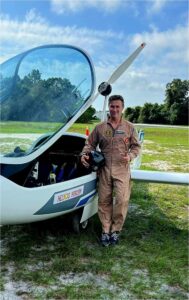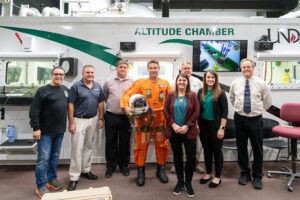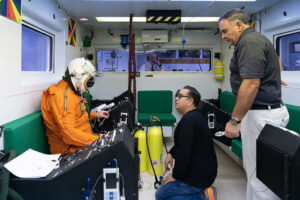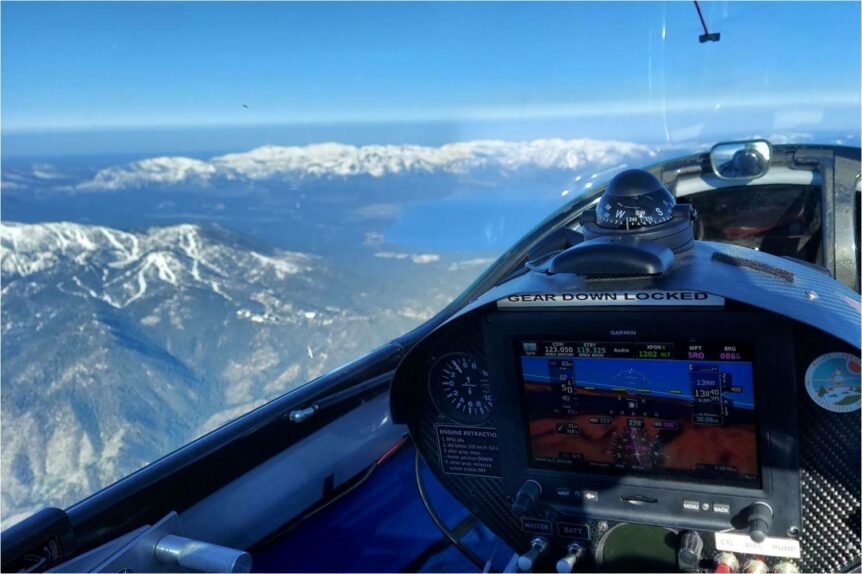Altitude records are tricky. Aiming for new heights requires careful definition of one’s launch points, means of elevating oneself, and apparently adherence to a tightly defined set of rules. Helios Horizon set some new altitude records last year, and hopes to reach even higher soon. Its eventual goal is to fly “into earth’s stratosphere”– in an electric aircraft.
Records at Altitude – and Speed
This might seem like a bit of a step down for Miguel Iturmendi, the founder and test pilot for the Helios Horizon project. He’s already been to 65.605 feet (19.9 kilometers) in Perlan II, on August 28, 2018. As the Saratoga Times notes, the flight hit “The fastest known speed of Mach 0.48—roughly half the speed of sound—in a glider over El Calafate, Argentina, which earned him and his team the Society of Flight Test Engineers’ James S. McDonnell Award, as well as a Triple Lennie Pin (an aviation award for soaring named for the lenticular clouds seen at altitude).”

Miguel Iturmendi with modified Pipistrel Taurus – flagship of the Helios Horizon Project
Only a week later, September 2, Perlan reached 76,124 feet pressure altitude with Jim Payne at the controls and Tim Gardner in the back seat.
The Federation Aeronautique Internationale (FAI) reported on Miguel’s event. “To achieve this high altitude flight, the purpose-built, pressurized high-altitude glider also passed the Armstrong Line, the point in the atmosphere at which human blood boils unless protected. The crew – Jim Payne and Miguel Iturmendi – use a specially designed closed-loop rebreather system, in which the only oxygen used is what the crew metabolizes. The aircraft’s wings designed to be able to fly in less than 3% of normal air density and at temperatures of minus 70 degrees C, conditions approximating the surface of Mars.”
Helios – Smaller and Simpler
Helios starts from a much simpler and smaller machine, sporting a 49.11 feet wingspan compared to Perlan’s 84-feet. Perlan’s wings, designed by Greg Cole, would not be competitive with contest sailplanes at lower altitudes, but would outshine them at higher elevation, as evidenced by its records.
Helios, a modified Pipistrel Taurus, comes from the factory with a 550 kilogram (1,213 pound) maximum take-off weight (MTOW). This is a light structure for carrying two people and a 4.75 kilowatt-hour battery.
The team modified the basic Taurus, however. They replaced the 35 kilowatt (47 horsepower) motor of the stock Taurus with a new motor weighing 10kg producing 54kW (72hp) of continuous power. They upped the Amps with six 8.5kWh, 32 kilogram (70.55 pounds) lithium-ion batteries with a cell-level energy density of 258 watt-hours per kilogram. “’Best in class anywhere’, Iturmendi says. They also installed a new motor controller, replaced the aircraft’s standard 168 [centimeter] (66in)-wide propeller with a 224cm (88.19 inch) version, and modified the aircraft’s flight controls, elevators and wings, which span 18.3meters (60.04 feet).”
Flying on recent missions with two battery packs, reaching higher will probably require the full six-pack to attain 44,000 feet, the edge of the stratosphere. Linking findings between Perlan and Helios could lead to a comprehensive understanding of our atmosphere at all levels.
Starting as a self-financed project (Miguel has $400,000 invested already), Helios is now looking for donors – at fairly modest levels – $50,000 according to Miguel. Altitude costs money, but even reaching the stratosphere will not take stratospheric sums for Helios. Already, the modified Taurus has set new records for all-electric aircraft weighing less than 500 kilograms (1,102 pounds).
“The goal is to be the first electric airplane that demonstrates a stratospheric flight,” says Iturmendi, who was born in Spain but has long lived in Sarasota.
“We want to demonstrate that electric aviation is doable. We want to inspire the next generation of scientists, engineers, technicians, mechanics, designers – to show that all of this is possible.”
Suiting Up
Because the Helios Horizon is, unlike Pelan, unpressurized, flights at its highest altitudes will require Miguel to wear a pressure suit. Iturmendi, “Knows Pablo de León, chair of the Department of Space Studies, [at the University of North Dakota] and his work designing spacesuits. The pair spoke at a conference in Argentina in April, and Iturmendi broached the idea of using UND’s altitude chamber'” according the University newspaper. DeLeon obtained the approval of Aerospace Dean Robert Kraus and the test began on November 8. Iturmendi breathed pure oxygen for 100 minutes, then the chamber’s door was sealed.
The test got started at 9 a.m. Nov. 8, with Iturmendi breathing pure oxygen for about 100 minutes, purging the blood of nitrogen prior to the chamber door being sealed.

Helios Horizon pilot Miguel Iturmendi stands with his project manager, Javier Merino (far left), UND Space Studies Chair Pablo De León and the UND team members who operate the high-altitude chamber. Photo by Arjun Jagada/School of Aerospace Sciences.
Several people were in the chamber with Iturmendi and standing by outside. Steven Martin, manager of aerospace physiology operations, sat at a control panel outside the chamber and questioned Iturmendi to check his cognitive functions. UND Today reports, “‘What’s 6 times 6 times 2?’ went one question.
“’72,’ Iturmendi answered, without difficulty.”
Eric Toutenhoofd, an aerospace physiology technician and instructor, was also inside the chamber — in a sealed and separate compartment Two Altru paramedics and an off-duty member of the Grand Forks Fire Department stood by outside but were not needed.

Miguel Iturmendi and Javier Merino, with Helios Horizon, go over equipment, while Pablo de Leon, UND Space Studies professor, assists. Photo by Arjun Jagada/School of Aerospace Sciences.
It may surprise that North Dakota would have a major educational interest in Aerospace. According to Wikipedia, “The John D. Odegard School of Aerospace Sciences (UND Aerospace) is a multidisciplinary college within the University of North Dakota (UND) in Grand Forks, North Dakota. The school was formed in 1968. The majority of the school’s fleet of over 120 aircraft is based at nearby Grand Forks International Airport and is the largest fleet of civilian flight training aircraft in North America. UND Aerospace also operates a flight training center at Phoenix–Mesa Gateway Airport in Mesa, Arizona. Today, the school has many aerospace-related programs including commercial aviation (fixed wing and rotorcraft), Unmanned aircraft systems operations, air traffic control, airport management, Space Studies, Computer Science, Atmospheric Sciences, and Earth System Science & Policy. Currently, the school has over 500 faculty and 2,000 students making it the second largest of UND’s degree-granting colleges.”
With his aircraft, suit and himself ready for more, their next tests will take place high over Nevada. We hope for the best and record highs for Miguel and Helios Horizon.

